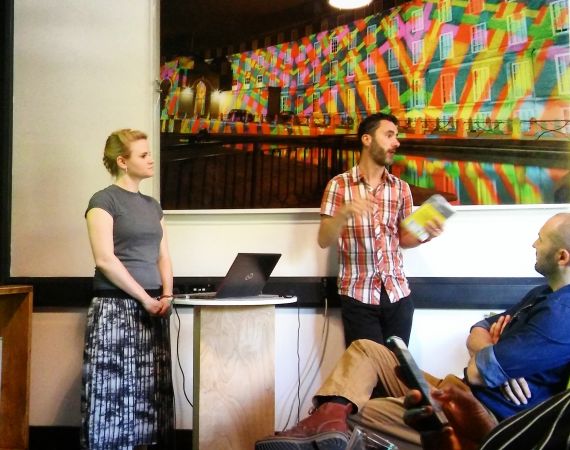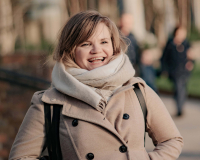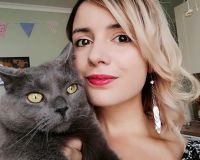Lunchtime talk write-up
Posted on Tue 30 May 2017
Future DiverCities: The Art And Culture Of Changing City-Scapes
The role of art and culture in the city is changing. Moving from the arts venue and audience, towards going ‘out’ into the city, nurturing a vision of the city itself as a creative, participative space in which citizens are themselves makers are "co-creators". Eleanor Pender spoke to us about…

Posted by
Speaker

Eleanor Pender
Lecturer and project management consultant with over ten years of experience in the arts, cultural and creative sectors. Research interests in interactive fiction, audience agency, immersive storytelling.The role of art and culture in the city is changing. Moving from the arts venue and audience, towards going ‘out’ into the city, nurturing a vision of the city itself as a creative, participative space in which citizens are themselves makers are "co-creators".
Eleanor Pender spoke to us about Future DiverCities, a four-year programme funded by Creative Europe. Ten European partners in Europe and Canada are working together to encourage and support creativity, digital innovation, and art production within the cities and urban spaces of Europe and beyond; exploring the ever-changing role of art in the urban context, very much inspired by Charles Landry and his concept of the City 3.0.
Future DiverCities' ten partners consist of city making organisations to arts festivals, city councils to tech companies. Eleanor shared with us news from the four week-long workshop ‘Labs’, delivered in the first year of the project under the theme ‘Future DiverCitizens.
Five Things I Learned
1.Future DiverCities is currently in the first year of a four year long programme with aims to have four to five labs per year across their partners, strengthening communities through art, city focus and user centric experience. So far labs have taken place in Kuopio, Berlin, Marseille and Bergen. The first was led by Finnish partner ANTI Festival (Anti meaning Gift) in Kuopio September 2016. The project involved 4 artists over a period of 6 days led by The Map Consortium (UK) around the idea of Over-Mapping. This involved placing a map of Kuopio in a public space like a shopping mall and allowing people to emotionally map the country, they could place a sticker on the last place they felt happy for example. They then added another layer to the map by sonically mapping memories on top creating a multi-layered map.
2. Digital Calligraffiti, initiated by Berlin partners Public Art Lab, was a project that worked with Palestinian graffiti artist Hamza Abu Ayyash and Canadian artist Michael Ang. The project worked with traditional calligraphers as well as new media artists to create meaningful phrases and tags using a device called The Infl3ctor, which then projected writing onto public spaces. The project evolved when the project engaged Berlin refugees using the same ideas and technology. This created the opportunity for recent refugees to express themselves through the exploration of language and identity and resulted in a live performance on the Berlin subway. The response was positive and opened up discussions between people on the subject of migration.
3. As a part of Marseille arts festival CHRONICS Act 3 - Revelations, French partner Seconde Nature offered an eight-day workshop with the aim to collectively design, create and make a series of portable, connected, open-source sequential lamps. Inspired by his work the City Lights Orchestra, artist Antoine Schmitt led this co-creation with Belgian designer Damien Gernay. Participants were young people looking to develop digital skills, art students and members of the public interested in light, technology and making. City Lights Orchestra is an open visual symphony in the city. At night, each computer connected to the internet illuminates the window of the office or home, blinking, pulsing, beating. Light goes on and off, each according to its own score, but in time with all the others. The City Light Orchestra was performed as part of the Revelations Festival in January 2017 at the Labourdettes Towers in Marseille, complimenting the workshop activities.
4. Taking place in May in Norway, 'From Macro to Micro and Back: the physics and metaphysics of distance', was a project featuring four artists - Kirsti Van Hoegee, Emma Fält, Njål Clementsen, Myriel Milicevic - who explored the theme of distance under the guidance of artists Piotr Pajchel in collaboration with Anne Marthe Dyvi. The project looked to highlight how technology and new tools impact us and our thinking, and how collaboration can open up our knowledge in a learning situation. The project wanted to focus on the impact of drone cameras, constant tracking and monitoring from above. The idea that we are being watched, but also have the ability to watch the Earth’s surface at any coordinates, at any moment. This was explored using drones and learning to capture moving images using moving cameras. Throughout the project, artists co-operated in their research placing the distance between micro and macro as the subject of thinking and exploration.
5. Bristol will be involved during year 2/3 of the Future DiverCities programme; for a weeklong lab in Bristol in the Autumn 2018. The lab will have a strong social inclusion focus with the aim of creating a legacy, not just a one off event. Later this year Superact/Future DiverCities will be part of the Future City programme with Festival of Ideas, which will be announced soon. Keep up-to-date via futuredivercities.eu or follow Future DiverCities on Twitter.
